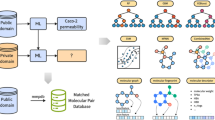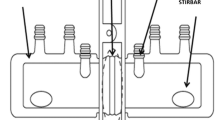Abstract
The ability to cross the intestinal cell membrane is a fundamental prerequisite of a drug compound. However, the experimental measurement of such an important property is a costly and highly time consuming step of the drug development process because it is necessary to synthesize the compound first. Therefore, in silico modelling of intestinal absorption, which can be carried out at very early stages of drug design, is an appealing alternative procedure which is based mainly on multivariate statistical analysis such as partial least squares (PLS) and neural networks (NN). Our implementation of neural network models for the prediction of intestinal absorption is based on the correlation of Caco-2 cell apparent permeability (P app) values, as a measure of intestinal absorption, to the structures of two different data sets of drug candidates. Several molecular descriptors of the compounds were calculated and the optimal subsets were selected using a genetic algorithm; therefore, the method was indicated as Genetic Algorithm–Neural Network (GA-NN). A methodology combining a genetic algorithm search with neural network analysis applied to the modelling of Caco-2 P app has never been presented before, although the two procedures have been already employed separately. Moreover, we provide new Caco-2 cell permeability measurements for more than two hundred compounds. Interestingly, the selected descriptors show to possess physico-chemical connotations which are in excellent accordance with the well known relevant molecular properties involved in the cellular membrane permeation phenomenon: hydrophilicity, hydrogen bonding propensity, hydrophobicity and molecular size. The predictive ability of the models, although rather good for a preliminary study, is somewhat affected by the poor precision of the experimental Caco-2 measurements. Finally, the generalization ability of one model was checked on an external test set not derived from the data sets used to build the models. The result obtained is of interesting practical application and underlines that the successful model construction is strictly dependent on the structural space representation of the data set used for model development.







Similar content being viewed by others
References
Lipinsky CA, Lombardo F, Dominy BW, Feeney P (1997) Adv Drug Deliv Rev 23:3
Yamashita F, Hashida M (2004) Drug Metab Pharmacokin 19:327
Motulsky H, (1995) Intuitive biostatistics, Oxford University Press, New York
Song XH, Yu RQ (1993) Chemom Intell Lab Syst 19:101
Hirst JD, King RD, Sternberg MJE (1994) Comp Aided Mol Design 8:405
Breindl A, Beck B, Clark T (1997) J Mol Model 3:142
Goll ES, Jurs PC (1999) J Chem Inf Comput Sci 39:974
Patankar SJ, Jurs PC (2000) J Chem Inf Comput Sci 40:706
Yang L, Wang P, Jiang Y, Chen J (2005) J Chem Inf Model 45:1804
Wessel MD, Jurs PC (1995) J Chem Inf Model 35:841
Duprat AF, Huynh T, Dreyfus G (1998) J Chem Inf Comput Sci 38:586
Hildalgo IJ, Raub TJ, Borchardt RT (1989) Gastroenterology 96:736
Artursson P (1990) J Pharm Sci 79:476
Artursson P, Karlsson J (1991) Biochem Biophys Res Commun 175:880
Delie F, Rubas WA (1997) Crit Rev Ther Drug Carrier Syst 14:221
Fujiwara S, Yamashita F, Hashida M (2002) Int J Pharm 237:95
Yamashita F, Wanchana S, Hashida M (2002) J Pharm Sci 91:2230
Molconn-Z software, Hall Associated Consulting, Quincy, MA
Artursson P, Palm K, Luthman K (1996) Adv Drug Deliv Rev 22:67
Cruciani G, Crivori P, Carrupt PA, Testa B (2000) THEOCHEM -J Mol Struc 503:17
Sisto A, Caciagli V, Altamura M, Giolitti A, Fedi V, Guidi A, Giannotti D, Harmat N, Nannicini R, Pasqui F, Maggi CA, WO03037916, MENARINI RICERCHE SPA and inventors, 2003
Fattori D, Porcelloni M, D’Andrea P, Rossi C, Altamura M, Maggi CA, WO2004094412, MENARINI RICERCHE SPA and inventors, 2004
Pearlman RS, Concord distributed by Tripos Inc., St. Louis, Missouri, 63144, USA
Crivori P, Cruciani G, Carrupt PA, Testa B (2000) J Med Chem 43:2204
Cruciani G, Pastor M, Clementi S (2000) In: Gundertofte K, Jørgensen FS (eds) Molecular modeling and prediction of bioactivity. Springer, Berlin, pp 73–82
Guba W, Cruciani G (2000) In: Guntertofte K, Jørgensen FS (eds) Molecular modeling and prediction of bioactivity. Springer, Berlin, pp 89–94
ACD/pKa Batch, Advanced Chemistry Development, Inc.: Toronto ON, Canada, www.acdlabs.com, 2003
Bishop CM, (ed) (1995) Neural networks for pattern recognition. Oxford University Press Inc., New York
Wessel MD, Jurs PC, Tolan JW, Muskal SM (1998) J Chem Inf Comput Sci 38:726
Agatonovic-Kustrin S, Beresford R, Yusof APM (2001) J Pharm Biomed Anal 25:227
So SS, Karplus M (1996) J Med Chem 39:1521
So SS, Karplus M (1996) J Med Chem 39:5246
Yasri A, Hartsough D (2001) J Chem Inf Comput Sci 41:1218
Guha R, Jurs PC (2004) J Chem Inf Comput Sci 44:1440
Marini F, Roncaglioni A, Novič M (2005) J Chem Inf Model 45:1507
Rogers D, Hopfinger AJ (1994) J Chem Inf Comput Sci 34:854
Leardi R (2001) J Chemometr 15:559
Lavine BK, Davidson CE (2003) J Chem Inf Comput Sci 43:1890
Luke BT (1994) J Chem Inf Comput Sci 34:1279
Zupan J, Gasteiger J (eds) (1999) Neural networks in chemistry and drug design Wiley-VCH, Weinheim
Levenberg K (1944) Quart Appl Math 2:164
Marquardt D (1963) SIAM J Appl Math 11:431
Gill PE, Murray W (1978) SIAM J Numer Anal 15:977
Hagan MT, Menhaj M (1994) IEEE Transactions on Neural Networks 5:989
Nguyen D, Widrow B (1990) Proc Int Joint Conference Neural Networks 3:21
Nelson MC, Illingworth WT (eds) (1991) A practical guide to neural nets, Addison-Wesley, Reading, MA USA
Stone M (1974) J R Statist Soc B 36:111
Stone M (1978) Math Operationsforsch Statist Ser Statistics 9:127
Wahaba G, Wold S (1975) Commun Statist 4:1
Perrone MP, Cooper LN (1993) In: Mammone RJ (ed) Artificial neural network for speech and vision. Chapman & Hall, London, pp 126–142
Perrone MP (1993) In: Mozer MC et al (eds) Proceedings Connectionist Models Summer School, Lawrence Erlbaum, Hillsdale NJ, pp 364–371
Yazdanian M, Glynn SL, Wright JL, Hawi A (1998) Pharm Res 15:1490
Stuper AJ, Brugger WE, Jurs PC (eds) (1979) Computer-assisted studies of chemical structure and biological function. Wiley-Interscience, New York
Lipinski CA (2000) J Pharmacol Toxicol 44:235
Goodford PJ (1985) J Med Chem 28:849
GRID 22, Molecular Discovery Ltd., http://www.moldiscovery.com
Acknowledgment
A. D. F. is grateful to Menarini Ricerche SpA for a post-doctoral fellowship allowing her to carry out research activity at IPCF, and to Dr. Giovanni Barcaro (IPCF, CNR, Pisa), Dr. Roberto Bartolini (ILC, CNR, Pisa) and Dr. Marco Galimberti (IPCF, CNR, Pisa) for several helpful discussions. We thank Dr. Rose-Marie Catalioto (Menarini Ricerche S.p.A, Firenze) who performed the Caco-2 Papp measurements and Dr. Antonio Triolo (Menarini Ricerche S.p.A., Firenze) for MS analysis.
Author information
Authors and Affiliations
Corresponding author
Electronic supplementary material
Below is the link to the electronic supplementary material
Rights and permissions
About this article
Cite this article
Di Fenza, A., Alagona, G., Ghio, C. et al. Caco-2 cell permeability modelling: a neural network coupled genetic algorithm approach. J Comput Aided Mol Des 21, 207–221 (2007). https://doi.org/10.1007/s10822-006-9098-3
Received:
Accepted:
Published:
Issue Date:
DOI: https://doi.org/10.1007/s10822-006-9098-3




